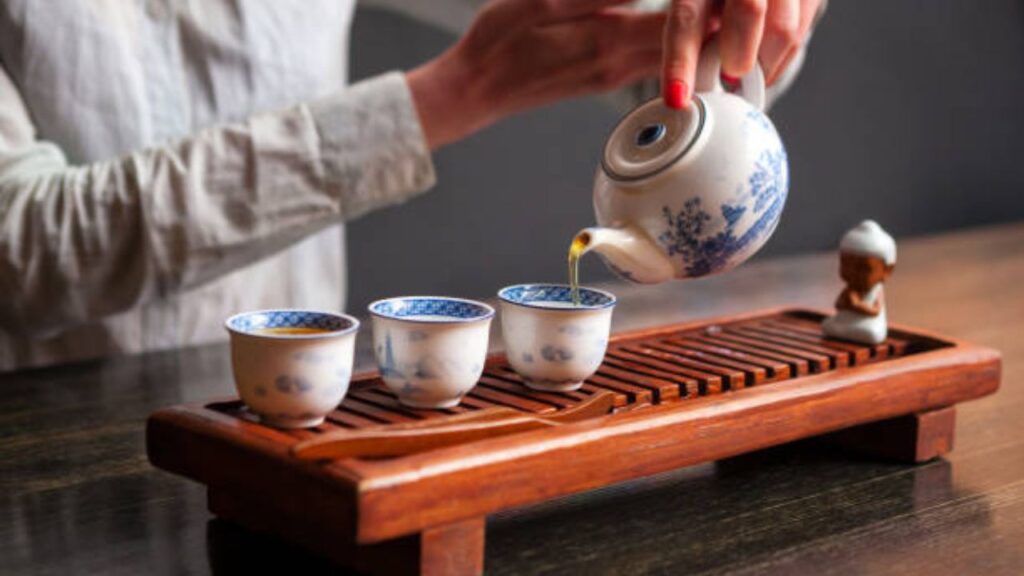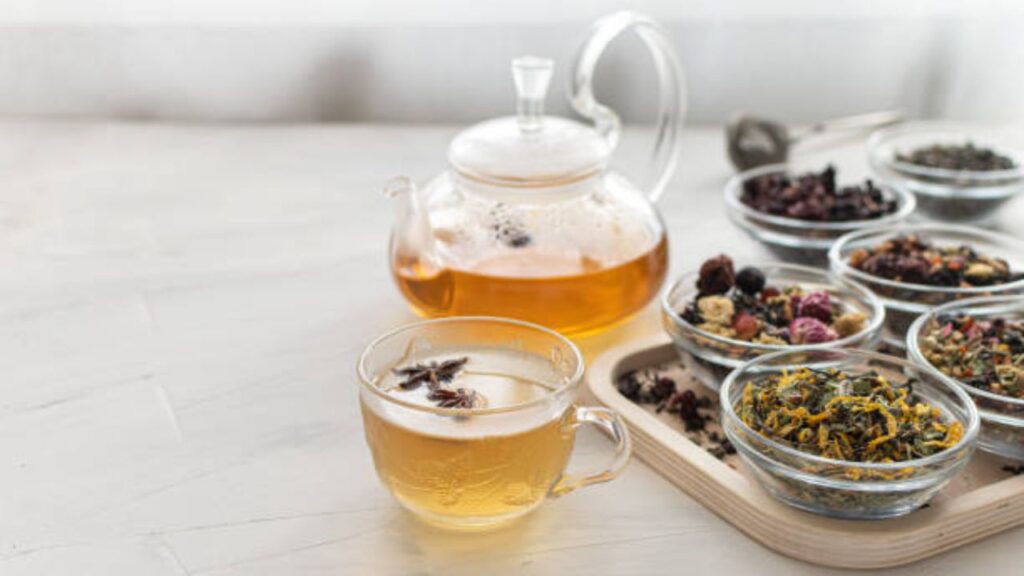Chinese restaurant tea constitutes a cultural greeting, a digestive aid, and a basic component of the eating experience—far more than simply a drink. A pot of warm tea appears uninvited the minute you sit down throughout many Chinese restaurants across the globe. But just exactly what fills those cups? Although menus vary, numerous teas predominate in these settings because they compliment many tastes, aid digestion, and preserve centuries-old customs. Let’s investigate the fragrant universe of these dear beers and find the reason they stay inseparable from the Chinese eating experience 3613.

Jasmine Tea: The Quintessential Welcome
Particularly popular in Cantonese dim sum eateries, jasmine tea is the most often found kind of Chinese tea offered in restaurants. Made with beautiful jasmine flowers that scent green tea leaves, this tea is a delicate brew with a pale yellow-green hue and a softly sweet aroma. Its appeal is not accidental; jasmine’s reviving properties balance rich, fatty foods like steamed buns and dumplings, therefore resetting the palate between bites. For many guests, the tea’s mild astringency and comforting scent appeal worldwide and evoke the very core of Chinese restaurant tea. Loose-leaf variants, which unfold completely in hot water and release more flavors than bagged kinds, are favored by restaurants. To retain the floral notes 3610, steep for two to three minutes using water heated to 180°F (82°C).
Oolong Tea: The Versatile Middle Ground
An adaptable star in Chinese restaurants, semi-oxidized oolong tea finds the ideal mix between black tea’s strength and green tea’s freshness. Two varieties usually show up: darker, roasted oolongs like Da Hong Pao, providing nutty or woodsy aromas; Tie Guan Yin (Iron Goddess of Mercy), with its flowery orchid overtones and greenish tint, seems Savory foods like roast duck, char siu (BBQ pork), or stir-fries fit Oolong’s modest caffeine level and silky texture. Its enzymes help break down fat, which is a useful advantage with meals heavy in meats and oils. To extract their various layers, tea masters brew oolong near-boiling (195–205°F/90–96°C), and premium leaves can be steeped several times, developing in taste with each pour 3810.
Pu-erh Tea: The Digestive Powerhouse
Rich, fatty dishes like Peking duck or Sichuan hot pot call for ripe Pu-erh tea (shou Pu-erh), the most often used Chinese restaurant tea. Microbial aging causes this Yunnan Province fermented black tea to produce an earthy, smooth character with hints of damp leaves, chocolate, or dried fruit. Perfect after a feast as Pu-erh’s enzymes break down lipids and improve digestion. Although fine aged Pu-erh can be expensive, most restaurants utilize reasonably priced loose-leaf combinations, strong in big pots. Before a 30 to 60-second steep, gently rinse the leaves under hot water to prepare them appropriately The end effect is a dark, soothing beverage that balances strong tastes without bitterness 367.
Green Tea: The Regional Specialty
While less ubiquitous than jasmine or oolong, pure green tea finds expression in eateries stressing regional cuisines. Pan-fired tea from Hangzhou, Longjing (Dragon Well), has nutty, chestnut-like flavors and goes rather well with fish or veggie cuisine. With its spiral-shaped leaves, biluochun gives flowery and fruity cues. To reduce bitterness and produce a light green-yellow infusion, these little oxidized teas brew best at lower temperatures—175–185°F/80–85°C. Although susceptible to overcooking, their great antioxidant value and refreshing taste make them a classy option in venues presenting teas of origin 31013.

Chrysanthemum Tea: The Herbal Refresher
Popular in Sichuan or hot pot restaurants specifically, chrysanthemum tea offers a caffeine-free substitute. Made just from dried yellow chrysanthemum blossoms, it produces a golden, softly sweet brew with overtones reminiscent of honey. Considered “cooling,” Traditional Chinese Medicine (TCM) balances hot or fried meals that cause internal heat. Those with a light palate cleaner or those sensitive to caffeine frequently choose this choice. Some restaurants use it with Pu-erh or green tea to accentuate flowery brightness from earthy undertones. No washing is required; steep chrysanthemums in boiling water for three to five minutes.
Why Tea Matters in Chinese Dining
The Chinese restaurant tea chinese restaurants custom is not haphazard. First, it promotes digestion; teas such as oolong and Pu-erh assist to emulsify lipids. Second, it serves as a palette cleanser; the astringency of oolong or the scent of jasmine freshes taste receptors between meals. Rooted in customs like the Gongfu ceremony, culturally drinking tea shows respect and friendliness. Warm tea practically complements TCM ideas by balancing “yin,” (cool) and “yang,” (warm) energy in meals. Beyond chemistry and custom, drinking tea fosters community ties and transforms meals into shared memories 369.
Cultural Threads and Modern Rituals
The purpose of tea goes beyond just flavor. While tapping two fingers on the table (a remnant of Emperor Qianlong’s clandestine voyages) softly acknowledges the pourer, pouring for others before oneself shows respect. Leaving a teapot lid open communicates a want for refills, a useful hint in busy dining rooms. Tea culture stands out clearly in southern China when you look at southern dishes using regional teas. Though they are less prevalent in casual eateries, rituals like Gongfu—using Yixing clay pots—emphasize awareness and quality in every precisely made pot 6913.

Brewing Authentic Chinese Tea at Home
Recreating Chinese restaurant tea requires four keys:
- Loose-leaf tea: Opt for whole leaves over dust-filled bags for fuller flavor.
- Proper temperature: Green/jasmine teas need cooler water (175–185°F); oolong, black, and Pu-erh require near-boiling (195–212°F).
- Adequate leafing: Use 1–2 teaspoons per 8 oz cup—restaurants brew strong to withstand meal flavors.
- Multiple infusions: Especially for oolong or Pu-erh, reuse leaves 3–5 times, adding 15 seconds per steep.
Invest in a simple gaiwan (lidded cup) or teapot, and always rinse Pu-erh or tightly rolled oolongs with a quick “wash” of hot water before drinking 3812.
Here’s an engaging, human-written comparison table and a concise “Why” section that captures the heart of Chinese restaurant tea service:
Chinese Restaurant Tea
| Tea Type | Flavor & Feel | Why It’s Served | Best For… |
| Jasmine Tea | Light, floral, gently sweet. Like a fragrant breeze. | The ultimate welcome! Cleanses the palate, universally liked. | Dim sum, dumplings, lighter dishes. Starters! |
| Oolong Tea | Versatile! Ranges from floral & green (Tie Guan Yin) to toasty & rich (Da Hong Pao). Smooth. | Balances any meal. Aids fat digestion. Adaptable. | Roast duck, BBQ pork, stir-fries. The all-rounder! |
| Pu-erh (Ripe) | Earthy, deep, smooth (think forest floor or dark chocolate). Bold. | Digestive powerhouse! Cuts through grease like a champ. | Heavy feasts: Peking duck, hot pot, fried foods. |
| Green Tea | Fresh, grassy, sometimes nutty (Longjing) or fruity (Biluochun). Clean & light. | Highlights regional specialties. Refreshing & high in antioxidants. | Seafood, steamed veggies, delicate flavors. |
| Chrysanthemum | Naturally sweet, honey-like, floral. Caffeine-free & calming. | “Cooling” effect (TCM). Great for spice/fried food. Gentle palate reset. | Spicy Sichuan, hot pot, or when avoiding caffeine. |
Conclusion
Chinese restaurant tea is an essential component of the experience, not only a beverage. There is a reason that a boiling pot is coming to your table. Each brew is selected purposefully, from the aromatic greeting of jasmine, the flexible balance of oolong, the earthy digestive help of pu-erh, a delicate green tea, or calming chrysanthemum.
FAQ’s
1. What’s the most common tea served in Chinese restaurants?
Certainly the most often consumed is jasmine tea! Especially in dim sum places, you will often find its mild, flowery taste appealing right away once seated. It’s reviving and goes wonderfully with various foods.
2. Why is Pu-erh tea often served with heavy meals?
Due to its digestive benefits, fermented black tea or pu-erh, is widely listed on Chinese restaurant menus. Since pot dishes and Peking duck have such earthy flavors, it makes sense that those who work with them crave them.
3. Is there a tea that’s both green and black?
Oolong tea is what I mean here. Sitting exactly between green and black teas, it is just partly oxidized. From flowery to toasted, it provides a broad spectrum of tastes and is quite flexible, complimenting everything from BBQ pork to shellfish.
4. What does tapping fingers on the table mean when someone pours tea?
A discreet, classic approach to express “thank you” to the person pouring your tea is lightly tapping two or three fingers on the table. This modest act of respect comes from Chinese tea tradition.
5. Is there a caffeine-free tea option usually available?
Definitely yes! Popular caffeine-free option is chrysanthemum tea derived from dried flowers. Considered “cooling,” it has a naturally sweet, honey-like flavor and goes fantastic with fried or spicy meals.
